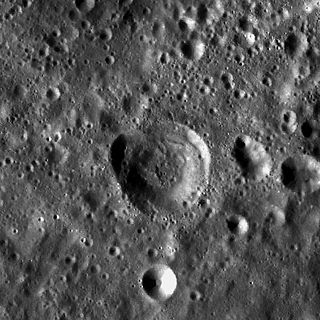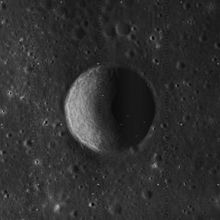
Aldrin is a small impact crater located on the southern part of the Mare Tranquillitatis, to the east of Sabine. It is located about 50 kilometers to the northwest of the Apollo 11 landing site, Tranquility Base. Named after Buzz Aldrin, the crater is the westernmost of a row of three craters named in honor of the Apollo 11 crew members. About 30 kilometers to the east is the landing site of the Surveyor 5 lunar probe.

Brayley is a lunar impact crater located in the southwest part of the Mare Imbrium. It was named after British geographer Edward W. Brayley in 1935. It has a circular rim and a low rise in the center. There are no notable craters overlapping the rim or interior. The sinuous rille Rima Brayley passes to the north of Brayley.

Collins is a tiny lunar impact crater located on the southern part of the Mare Tranquillitatis. It is located about 25 kilometers to the north of the Apollo 11 landing site, Tranquility Base. Named after American astronaut Michael Collins, the crater is the central member of the row of three craters named in honor of the Apollo 11 crew members. About 15 kilometers to the west-northwest is the landing site of the Surveyor 5 lunar probe.

Ching-Te is a small lunar impact crater located in a mountainous area to the east of the Mare Serenitatis. It is a circular, bowl-shaped formation with no distinguishing features.

Euclides is a small lunar impact crater located near the eastern edge of Oceanus Procellarum, about 30 kilometers to the west of the Montes Riphaeus mountains. The mare in the vicinity is devoid of significant craters, but to the west is an area of low rises. The crater is named after the Greek mathematician Euclid.

Amici is a lunar impact crater that is located on the rugged far side of the Moon. It lies to the south of the larger crater Icarus, to the north of McKellar.

Anders is a worn lunar impact crater that is located in the southern hemisphere on the far side of the Moon. It lies just to the southeast of the outer rim of the huge walled basin named Apollo. To the south-southeast is the crater Leavitt.

Asada is a small lunar impact crater located at the northern edge of Mare Fecunditatis, to the northeast of the crater Taruntius. It is a circular crater formation with inner walls that slope down toward a small central floor at the midpoint. Asada was designated Taruntius A prior to being named by the IAU.

Clerke is a tiny lunar impact crater named after Irish astronomer Agnes Mary Clerke, who played a role in bringing astronomy and astrophysics to the public in Victorian England. It is located near the eastern edge of Mare Serenitatis in the midst of a rille system named the Rimae Littrow after the crater Littrow to the east. It is roughly circular and cup-shaped, with a relatively high albedo. In a valley to the southeast is the landing site of the Apollo 17 mission. Clerke was previously designated Littrow B.

Sabine is a lunar impact crater that forms a nearly matching pair with Ritter to the northwest. The two rims are separated by a distance of only a couple of kilometers. To the west is the bowl-shaped crater Schmidt, and farther to the north are Manners and Arago. Its diameter is 30 km. It was named after Irish physicist and astronomer Edward Sabine.

Encke is a lunar impact crater that is located on the western edge of the Mare Insularum, to the south-southeast of the crater Kepler. The small crater Kunowsky lies to the east-southeast on the mare.

Apollo is an enormous impact crater located in the southern hemisphere on the far side of the Moon. This formation dwarfs the large crater Oppenheimer that is located next to the western rim. The crater Barringer lies across the northern wall. To the southeast is the crater Anders, and Kleymenov is just to the east of the rim.

Borman is a lunar impact crater that is located in the southern hemisphere on the far side of the Moon. It lies across the southeast section of the mountainous inner ring, within the walled basin named Apollo.

Barringer is a lunar impact crater that is located on the southern hemisphere on the Far side of the Moon, named after geologist Daniel Barringer. It is attached to the north-northeastern rim of the walled basin named Apollo, and lies to the southeast of Plummer. South of Barringer, on the floor of the Apollo basin, is the crater Scobee.

Firmicus is a lunar impact crater that lies in the eastern part of the Moon's near side, so that from Earth it appears oval in shape due to foreshortening. It is, however, very nearly circular. The crater is located to the west of the Mare Undarum, and northeast of the similar-sized crater Apollonius. To the north of Firmicus are the craters van Albada and Auzout. Attached to its northwest rim is the Lacus Perseverantiae, a miniature lunar mare.

Dollond is a small lunar impact crater that is located in the central region of the Moon, to the north of the crater Abulfeda. It was named after British optician John Dollond. Due west of Dollond is Anděl. Dollond is circular and cone shaped, with a tiny floor at the midpoint of the sloping interior walls.

Coriolis is a lunar impact crater that is located on the far side of the Moon. The crater floor is bisected by the lunar equator, and it lies about three crater diameters northwest of the crater Daedalus.

Lovell is a small lunar impact crater that lies across the eastern edge of the walled plain Apollo, on the far side of the Moon. It has a somewhat irregular shape, with outward bulges to the north and west. The rim is sharp-edged, with some slight wear along the northwestern bend. The featureless inner walls slope directly down to the uneven interior floor.

Konstantinov is a lunar impact crater that is located to the southeast of the Mare Moscoviense, on the far side of the Moon. To the west of Konstantinov is the smaller crater Nagaoka, and to the south-southeast is the small Van Gent.

Leonov is a small lunar impact crater that lies to the south of Mare Moscoviense, one of the few maria on the far side of the Moon. This crater has a heart-shaped outline, due to an outward bulge along the northwest side. The rim of Leonov is worn, and several tiny craterlets lie along the edge. The inner walls and interior floor are relatively featureless.























